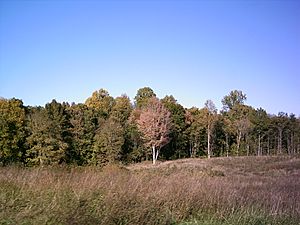Ca Ira, Virginia facts for kids
Ca Ira was once a small community located in Cumberland County, Virginia. It was officially started in 1796. After the American Civil War, the town slowly faded away. Today, only a few signs of the old town remain, like the historic Grace Church and a handful of houses.
The Story of Ca Ira
A Busy Little Town
At the start of the 1800s, Ca Ira was a typical small farming town in Virginia. It was located along Virginia State Route 632 and near the Willis River. This made it an important spot for moving goods, especially along the Willis River. The town got its name from a popular French marching song called "Ça Ira," which means "it'll be fine." This showed how excited people in Virginia were about the French Revolution at that time.
Even though the General Assembly officially created the town in 1796, it really grew between 1827 and 1860. In 1836, a writer named Joseph Martin described Ca Ira in his book, The Gazetteer of Virginia and the District of Columbia. He said the village had about 40 homes, three stores, a mill, a tobacco warehouse, two inns, a church, and a meeting hall.
About 310 people lived in Ca Ira at that time, and mail was delivered three times a week. Among the residents were people who worked as blacksmiths, wheel makers, tailors, and plow manufacturers.
How Ca Ira Grew
This community grew quickly after a dam was removed from a large pond nearby. Before this, the pond caused illnesses that almost completely emptied the town twice. Ca Ira didn't grow much until 1825, when the Willis River canal was finished. This canal helped in several ways. It removed the pond, which had been a source of poor health for the people living there.
More importantly, the canal opened up the town to the important tobacco trade. It made it much easier to transport goods along the James River. This connected Ca Ira to other counties like Prince Edward and Charlotte, and to bigger cities like Richmond and Petersburg.
During its busiest time, Ca Ira's three stores sold about $40,000 worth of goods each year. The mill ground 28,000 to 30,000 bushels of wheat during the season. Also, 300 to 500 large barrels of tobacco were brought into the town.
In 1843, Grace Church was completed. This became Ca Ira's most important building. It was not only a place for worship but also a gathering spot for people from nearby plantations.
The Decline of Ca Ira
However, the town's good fortune did not last. Ca Ira's peak was in the mid-1850s, when it even had a bank. But after the American Civil War, the town quickly declined. By the end of the 1800s, the church and most of the town were deserted.
A visit in 1906 found little more than a "post hamlet." Only a few houses, a post office, two stores, and the church remained among the ruins of old warehouses and other buildings. Today, only Grace Church still stands, though some newer houses have been built nearby.
Today, Virginia State Route 632 is known as "Ca Ira Road" where it passes through the site of the old village. Only a few buildings from this once busy village still exist along Route 632 near the Ca Ira Pond. These include Grace Episcopal Church, which is now on the National Register, about five simple homes, and the Ca Ira Fishing Club. Of these, only the church and the fishing lodge date back to Ca Ira's prosperous times.


